#kudamaki tsukasa
Text

ここだけの話ですよ?💚
576 notes
·
View notes
Text

🦊🧪
#東方project#touhou project#touhou#touhou fanart#2hu#my art#doodle#rkgk#tsukasa kudamaki#kudamaki tsukasa#tsukasa touhou#jump off a cliff
579 notes
·
View notes
Text


discord sillies
#touhou#tsukasa kudamaki#kudamaki tsukasa#chimata tenkyuu#tenkyuu chimata#darkydraws#first time drawing everyone's favorite failfox#the 46 legs panel is my favorite. honestly i think i nailed the expression
412 notes
·
View notes
Text

This fox can gaslight an entire population to play a new trading card game and not play it with you... she's busy gaslighting more potential players, after all!
Commission work!
Thankies a bunch for your Kon-tribution! <3 <3 <3
#touhou#touhou project#東方project#tsukasa kudamaki#kudamaki tsukasa#pizza tower#sprite art#sprite#sprite animation#art commisions#art commissions#commission#commission art
159 notes
·
View notes
Text


new isekais have dropped
503 notes
·
View notes
Text

Tsukasa and the Stolen Dress
Commission for @Rapid_Arthropod on twitter!
#my art#touhou#touhou project#touhou fanart#東方project#alt design#artists on tumblr#commission work#tewi inaba#tsukasa kudamaki#tsukasa touhou#tewi touhou#kudamaki tsukasa#inaba tewi#bowing#fox#kemonimimi
307 notes
·
View notes
Photo



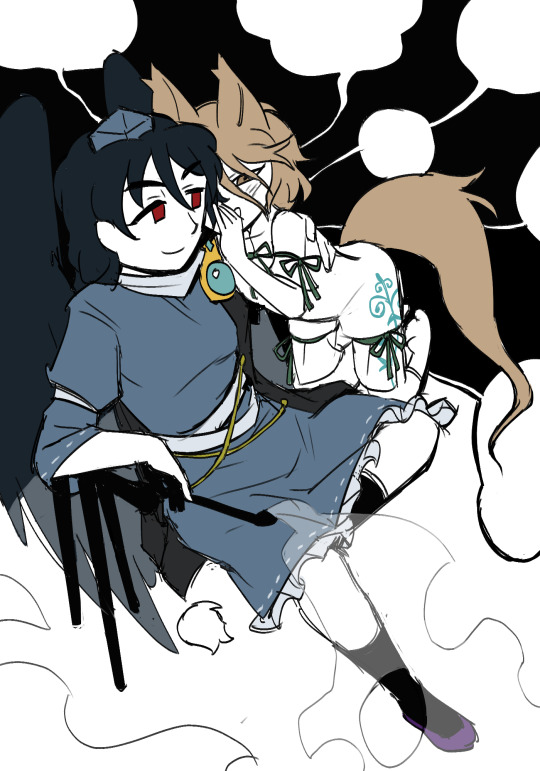


so.... I was drowing many touhou.
#touhou#marisa kirisame#reimu hakurei#satori komeiji#utsuho reiuji#fujiwara no mokou#kosuzu motoori#mononobe no futo#kyouko kasodani#byakuren hijiri#megumu iizunamaru#kudamaki tsukasa
1K notes
·
View notes
Text
Ran and company.


#koubudraw#touhou project#touhou#yakumo ran#toutetsu yuuma#kudamaki tsukasa#tegaki#touhouproject#art
210 notes
·
View notes
Text
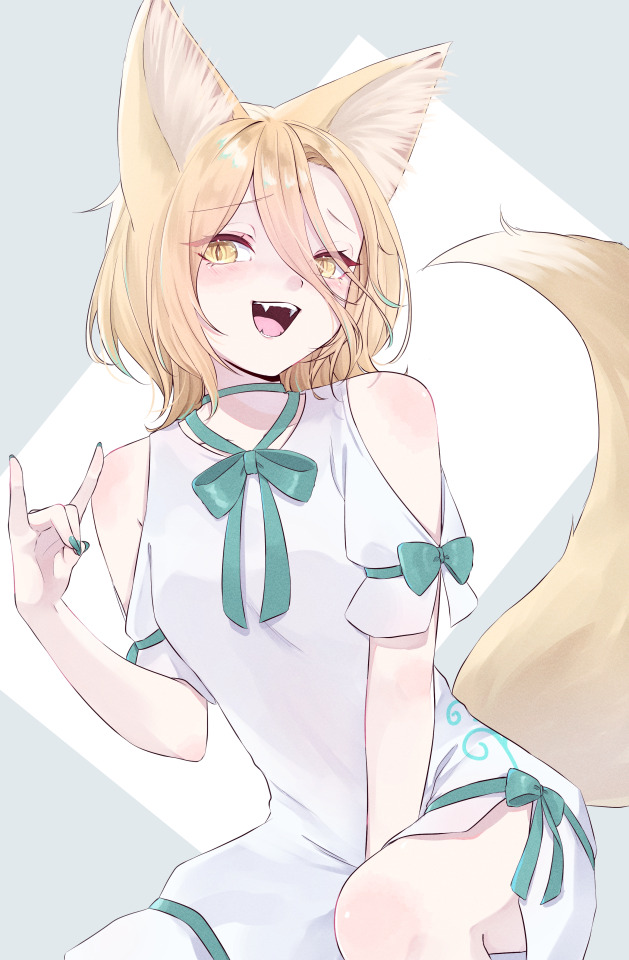
Kudamaki Tsukasa
#kudamaki tsukasa#touhou#safebooru#pixiv#art#tsukasa#fox girl#anime#manga#game#2hu#toho#tsukasa kudamaki#fangs
268 notes
·
View notes
Text
Consulting the convoluted history of supernatural foxes, or why is Tsukasa like that

I know I said you should only expect one long Touhou-themed research article per month, and that the next one will be focused on Ten Desires, but due to unforeseen circumstances a bonus one jumped into the queue. For this reason, you will unexpectedly have the opportunity to learn more about the historical and religious context of the belief in kuda-gitsune, or “tube foxes”, as well as their various forerunners. Tsukasa is clearly topical thanks to Unfinished Dream of All Living Ghost, and I basically skipped covering Unconnected Marketeers in 2021 save for pointing out some banal tidbits, so I hope this is a welcome surprise.
The post contains spoilers for the new game, obviously.
Obviously, in order to properly cover the kuda-gitsune, it is necessary to start with a short history of foxes in Japanese culture through history, especially in esoteric Buddhism.
Early history: the Chinese background
Early Japanese sources pertaining to foxes show strong Chinese influence. There was an extensive preexisting system of fox beliefs to draw from in continental literature, dating back at least to the Han dynasty (note that while the well known story of Daji is set much earlier, its modern form only really goes back to the Song dynasty). This is way too complex of a topic to discuss here in full, sadly, so I will limit myself to the particularly interesting tidbits.

A multi-tailed fox in the classic Chinese encyclopedia Gujin Tushu Jicheng (wikimedia commons)
It will suffice to say that historically the fox was perceived in China as a liminal being, and could be associated with pursuits regarded as ethically dubious, ranging from theft and banditry to instigating rebellions and promoting divisive religious views (so, for example during the reigns of firmly pro-Taoist emperors, Buddhist monks could be associated with foxes). Literary texts focused on supernatural foxes emphasized their shapeshifting abilities. In contrast with some of the other well attested supernatural beings in Chinese tradition, they could take a range of human forms, appearing as men and women of virtually any age. Often they favored mimicking people who lived on the margins of society, like bandits, courtesans or migrant laborers. It was also emphasized that they displayed a considerable degree of disregard for authority. The fact these animals lived essentially alongside humans without being domesticated definitely played a role in the formation of this image.
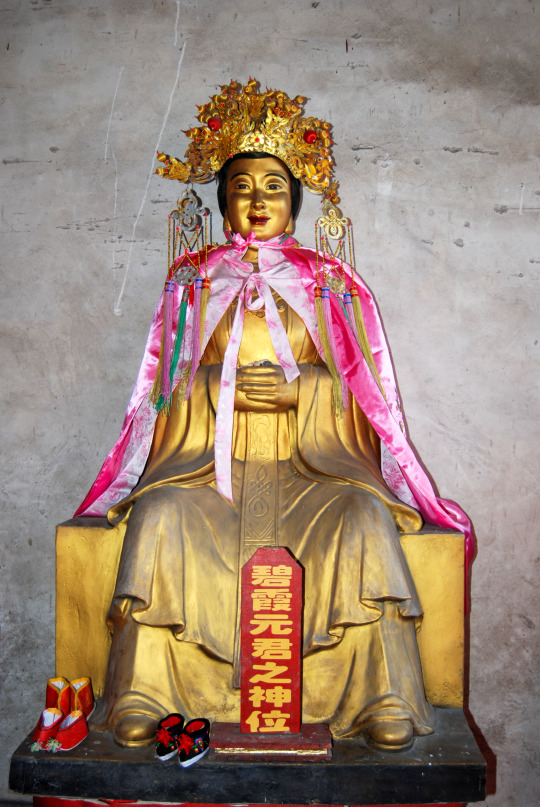
A contemporary statue of Bixia, a deity in the past associated with fox beliefs (wikimedia commons)
At the same time, foxes enjoyed a degree of popularity as objects of semi-official cult, still practiced here and there in China in modern times, for example in Boluo in Shaanxi. The religious role of foxes was reflected in, among other things, the development of terms like hushen (狐神) “fox deity”, or huxian (狐仙), “fox immortal”. The belief in such “celestial foxes” (tianhu, 天狐) was relatively common, and there is even a legend according to which there was a formalized way for the animals to transcend to higher states of existence, with the goddess Bixia making them undergo the supernatural fox version of the well known imperial examinations. If they failed they were condemned to live as “wild foxes” (yehu, 野狐) with no hope of transcendence. There are also accounts of foxes pursuing the status of a xian through illicit means, through a combination of praying to the Big Dipper and draining people’s energy, as documented by He Xiu in the 1700s. Note foxes were already portrayed as worshiping the Big Dipper during the reign of the Tang dynasty, but back then it was only believed this let them transform into humans.
The ambiguity of foxes is evident in the Japanese perception of these animals too. Supernatural foxes are probably among the best known youkai, and especially considering this is a post about Touhou I do not think the basics need to be discussed in much detail. They were believed to shapeshift and to steal vital energy, much like in China. Their positive role as messengers of Inari, a kami associated with agriculture, is generally well known too.
The earliest sources documenting encounters with supernatural foxes are obviously, as expected, the earliest chronicles like the Nihon Shoki, where they mostly appear as omens. By the Heian period these animals are well established in the written record. For instance, Nakatomi Harae Kunge includes “evil magic due to heavenly and earthly foxes” among phenomena which require ritual purification. In addition to the tales imported from China being in circulation, some setsuwa written in Japan involved shape shifting foxes. However, supernatural foxes only gained greater prominence in the Japanese middle ages due to the growth of relevance of two deities they were associated with, Inari and Dakiniten. The latter is more relevant to the topic of this article.
Foxes, Dakiniten and tengu

Part of a hanging scroll depicting Dakiniten riding on a fox (wikimedia commons, via MET; cropped for the ease of viewing)
The connection between foxes and Dakiniten reflected their associations with the dakinis, a class of demons in Buddhism. Originally the dakinis were associated with jackals instead, but Chinese Buddhist authors presumed that the animal mentioned in this context is basically identicial with more familiar foxes, and that belief reached Japan as well. It was strong enough for Dakinite, the dakini par excellence, to be regularly depicted riding on the back of a fox.
Dakiniten was originally a regular dakini, according to Bernard Faure specifically one who appears in Heian period Enmaten mandalas (Enmaten is related to but not quite the same as the better known king Enma, for the development of two distinct reflections of Yama in Buddhism see here). However, she eventually developed into a full blown deva in her own right, and her prominence was so great that it basically resulted in the decline of references to the generic dakinis in Buddhist literature in Japan. She was particularly popular in the Shingon school of Buddhism, and at the peak of her relevance played a role in royal ascension rituals, developing a connection with Amaterasu in the process (Amaterasu acquired many peculiar connections through the Japanese middle ages, it was par the course). A Tendai treatise equates her with Matarajin instead, though.
An interesting phenomenon related to Dakiniten is the occasional fusion of beliefs pertaining to foxes and tengu, which might have originated in the similarity of the terms tengu and the Japanese term for the already mentioned “heavenly foxes”, tenko. Its best attested examples include the inclusion of tengu in mandalas focused on Dakiniten as her acolytes. However, a different deity ultimately exemplifies this even better.
Iizuna Gongen and "iizuna magic"
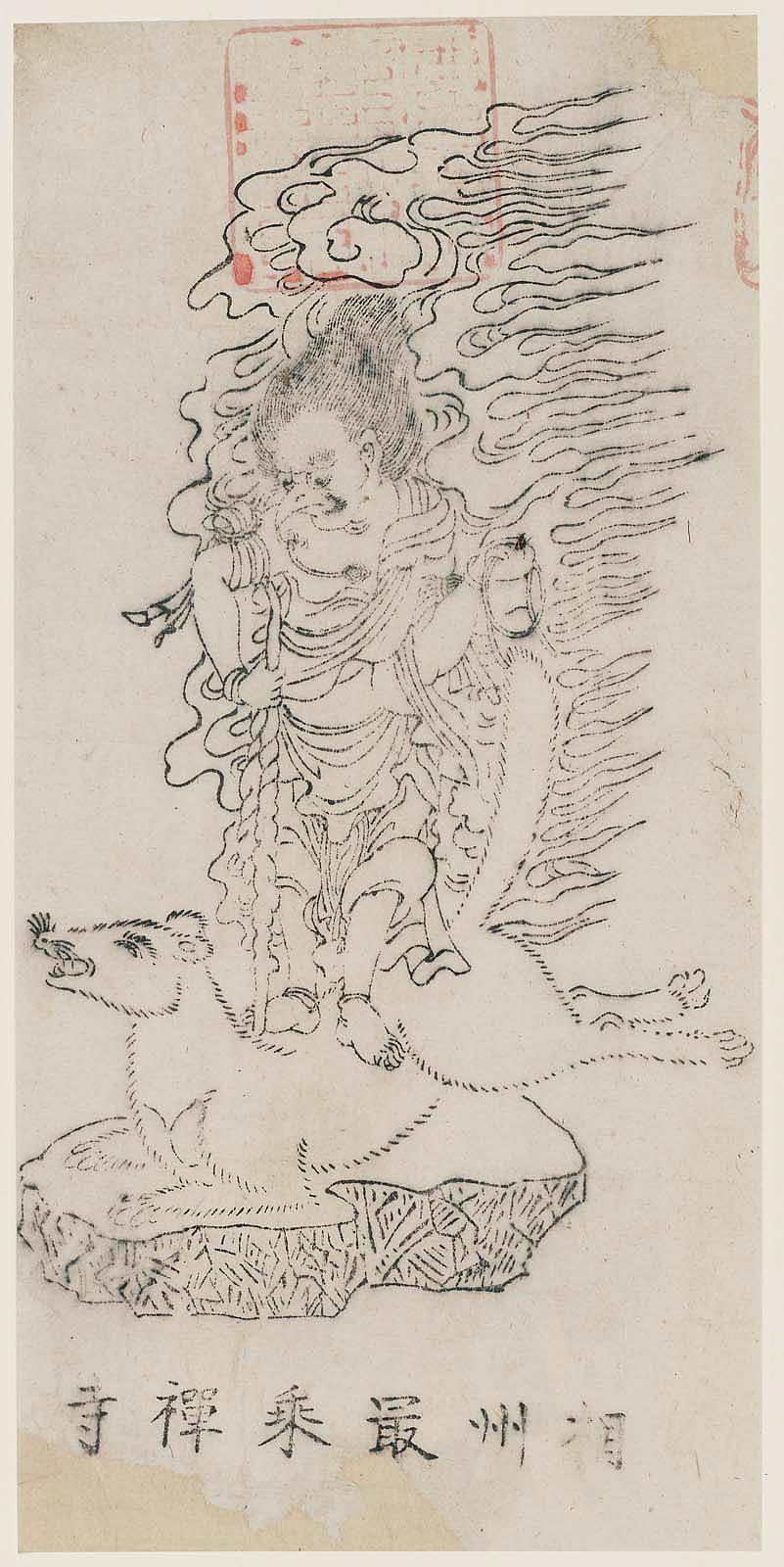
Iizuna Gongen riding on the back of a fox (Museum of Fine Arts Boston; link to the source is temporarily dead, the image is reproduced here for educational purposes only)
The indisputable center of the network of connections between foxes and tengu is Iizuna Gongen (飯綱権現), depicted as a tengu riding on a fox. As you can probably guess, he was a (vague) basis for Megumu, as evidenced by the similarity of the names. While many other aspects of his character aren’t really touched upon in the game, I’d hazard a guess he’s also the reason why ZUN decided to include a kuda-gitsune in the same game as Megumu - the evidence lines up exceptionally well, as you’ll see.
Originally Iizuna Gongen was simply the deity of Mount Iizuna (飯綱山), located in the modern Nagano prefecture. Near the end of the Japanese middle ages he spread to other areas, likely thanks to traveling shugenja (also known as yamabushi), mountain ascetics belonging to a religious tradition known as Shugendō. Two aspects of his character are particularly pronounced, his role as a martial deity and his association with foxes.
I was unable to determine when Iizuna Gongen’s connection to foxes originally developed, but it was strong enough to lead to the use of the alternate name Chira Tenko (智羅天狐; “Chira the heavenly fox”) to refer to him. Foxes also appear in a legend describing his origin. It states that he was one of the eighteen children of an Indian king, and arrived in Japan alongside nine of his siblings on the back of a white fox during the reign of emperor Kinmei (the remaining eight went to China and became monks on Mount Tiantai).
His connection to foxes is also reaffirmed in an Edo period treatise, Reflections on Inari Shrine (稲荷神社考, Inari jinja kō), which declares that names such as Iizuna Gongen and Matarajin (sic!) are used in the worship of wild foxes to hide the true nature of the invoked entities. The author further states that the true form of “these matarajin (plural) and wild foxes” is that of a three-faced and six-armed deity, which curiously has more to do with early Matarajin tradition than with Iizuna Gongen as far as I can tell. The two were not really closely associated otherwise, but it’s worth noting that apparently shugenja perceived them both as similar tengu-like deities.
The key feature of conventional iconography of Iizuna Gongen, the fox mount, has nothing to do with Matarajin strictly speaking, and likely reflects the influence of Dakiniten. However, the animal in this context developed its own unique identity thanks to the presence of foxes in a type of ritual focused on Iizuna Gongen, which could itself be referred to as iizuna. The shugenja community centered on the worship of Iizuna Gongen was not very formalized, which led to poor understanding of their practice among outsiders, with the term iizuna basically acquiring the vague meaning along the lines of “magic”. and rather poor reputation. These rites are where the kuda-gitsune comes into play.
Kuda-gitsune in iizuna magic and beyond

The kuda-gitsune, as depicted in Shōzan Chomon Kishū by Miyoshi Shōzan (Waseda University History Museum; reproduced here for educational purposes only)
At first glance, kuda-gitsune is just one of many local variants of the standard supernatural fox, similarly to the likes of ninko, osaki-gitsune or nogitsune. The etymology of its name is straightforward. I’m sure you can guess what the second half means, while kuda (管) in this context refers to a bamboo tube. You’d think the name would basically guarantee it was universally accepted that’s how one could carry such a critter undetected, but apparently there was an alternate explanation, namely that it was invisible. I have not seen any further discussion of this in literature, but I assume this might be connected to shikigami beliefs, as these quite often are described as invisible. Do not quote me on that, though. Even more bizarrely, there is no consensus that the animal meant was always a fox. According to Bernard Faure it is distinctly possible the term referred to a weasel.
Kuda-gitsune could be described as a type of shikigami, but note that this term had a much broader meaning in real life than in Touhou, and referred to basically any supernatural being which acted as an extension of the powers attributed to “ritual specialists” (祈祷師) such as onmyōji, shugenja or Buddhist monks. In Buddhist context, the analogous term could be gohō dōji (護法童子; “Dharma-protecting lads”), though there are also cases where gohō and shikigami are contrasted with each other. The shikigami category didn’t just consist of animated papercraft and animal spirits typically designated as such in popculture. Even the twelve heavenly generals defending the “medicine Buddha” Yakushi could be labeled as shikigami. Obviously, kuda-gitsune is closer to the familiar meaning of this term than to Buddhist deities, though.
People relying on kuda-gitsune were referred to as kitsune-tsukai (狐使い), which can be loosely translated as “fox tamer”, and it is said they were often shugenja. Given the popularity of the associated deity among them this shouldn’t really be a surprise.
Various supernatural abilities were ascribed to the kuda-gitsune. The ability to possess people attributed to other supernatural foxes was the domain of kuda-gitsune too. Apparently people afflicted by it were compelled to eat nothing but raw miso. Purportedly they were bringers of wealth - but said wealth did not necessarily come from legitimate sources. That, in turn, could lead to distrust or outright ostracism of people allegedly relying on foxes to acquire wealth. They also provided aid in divination, and could supposedly reveal past, present and future alike this way. However, they could look into the soul of anyone using them this way and learn their secrets. Bernard Faure notes that occasionally it was said that they even could even be utilized to kill enemies who attempted casting spells on their owner.
Shigeru Mizuki's kuda-gitsune
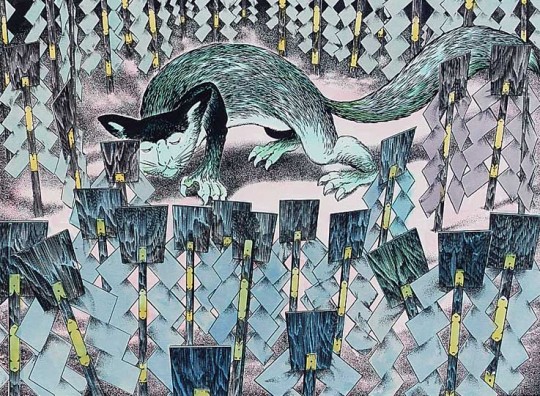
Kuda-gitsune, as depicted by Shigeru Mizuki (reproduced here for educational purposes only)
While there isn’t much information about kuda-gitsune in scholarship, especially scholarship available online in English, they received extensive coverage in various books about youkai written by Shigeru Mizuki, famous for arguably canonizing the modern concept of youkai. Note that while I am a fan of Mizuki's works, his encyclopedias are best understood as something closer to Borges’ Book of Imaginary Beings, complete with some dubious sourcing and possible fabrications. However, ultimately modern media about youkai, including Touhou, owes much to him, and arguably he continued the tradition of night parade scrolls which often invented new creatures wholesale, so it strikes me as entirely fair game to summarize what he has to say too.
Shigeru Mizuki cited the Edo period writer Matsura Seizan as an authority on kuda-gitsune. He states ccording to the latter, certain ascetics (yamabushi) were provided with these critters upon finishing their training on Mount Kinpu and Mount Ōmine. In his account cited by Mizuki there are a lot of details I haven’t seen elsewhere. The storage tubes after which kuda-gitsune are named apparently had to be inscribed with a certain sanskrit phrase (left unspecified, tragically) so that the animals didn’t have to be fed. However, releasing them and giving it food was necessary to gain their help in divination. There was a downside to this - kuda-gitsune were apparently hard to place back in containment once released without the help of a seasoned specialist. Also, they refused to provide anything of value unless fed well, and they had quite the appetite. Mizuki cites the particularly disastrous case of an ascetic who kept multiple kuda-gitsune in a single tube, and eventually couldn’t pay for enough food for his collection since the animals kept multiplying inside.
According to Mizuki it was believed that a kuda-gitsune could be gifted by its owner to another person, but the creature would come back if it was not satisfied with the food provided by the latter. If the original “fox tamer” dies before passing their kuda-gitsune to someone else, it will instead go to the Ōji Inari shrine located in what is now the the Kita ward of Tokyo.
Conclusion: Tsukasa and her forerunners
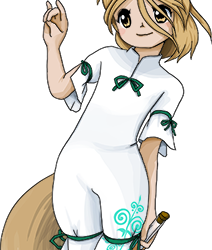
In theory I could’ve kept pointing out “see, it’s just like Tsukasa!” in virtually every single paragraph of this article. To answer the question from the title, evidently she is like that because that's how foxes have been in folklore both Japan and China for centuries.
It is not really hard to see that ZUN is genuinely great at research when he wants to be, and Tsukasa's character is remarkably accurate to her real life forerunners, both as an adaptation of kuda-gitsune specifically and as a representation of the broader tradition which lead to the portrayal of foxes as supernatural creatures of questionable moral character. She engages in morally dubious “get rich quick schemes”, she definitely provides advice (of variable quality), and her self-declared ability from her omake bio pretty clearly reflects skills actually ascribed to the kuda-gitsune in folklore. In the newest game the ability to provide information is clearly in the spotlight - Tsukasa seems to be reasonably knowledgeable (she brings up Kojiki in a line aimed at Hisami, among other things), and other characters generally agree she’d be more useful doing something else than fighting. I do not think there’s any real reason to doubt this is what is meant. I think it can even be safely assumed that Zanmu’s decision to pressure Tsukasa to partake in her assassination bluff is rooted in genuine tradition.
I’m obviously not going to say that Tsukasa reaches the platonic ideal of Okina, the quintessential character aimed at fans who like research, who largely seems to exist to get people to dig deeper for sources explaining the dozens of religious allusions in her dialogue, spell cards and design, but I do think it’s worth appreciating that the series reached a stage where even the minor animal youkai can be enjoyed as multilayered representation of centuries worth of genuine folklore and mythology.
Bibliography
-Bernard Faure, Gods of Medieval Japan vol. 1-3
-Michael Daniel Foster, The Book of Yokai. Mysterious Creatures of Japanese Folklore
-Berthe Jansen and Nobumi Iyanaga, Dākini (Brill’s Encyclopedia of Buddhism)
-Xiaofei Kang, The Cult of the Fox: Power, Gender, and Popular Religion in Late Imperial and Modern China
-Shigeru Mizuki’s assorted writings on kuda-gitsune (collected online here)
344 notes
·
View notes
Text
Tsukasa is not deftly manipulating the toxic polycule.
She's sleeping with members of it that hate each other and saying shit like "isn't the other one a bitch" to the bafflement and frustration of everyone, causing them to unite in their distaste for her.
"heheheh. All according to my plan" she says, homelessly.
69 notes
·
View notes
Text
the thing about tsukasa/sanae is that tsukasa’s strategies are optimised for dealing with people like iizunamaru “yes you SHALL attend me, minion, dohohoho” megumu, tenkyuu “that will be $69.99 sign here and here“ chimata, and himemushi “fine i’ll give you a pelvic fracture one handed if it will help you shut up” momoyo.
she has no idea how to handle someone whose response to a naked foxgirl lounging on her bed is to explain the “draw me like one of your french girls” meme. her every attempt at swagger makes her more swagless on this side of the kochiya sanae singularity. she is trying to simp for the unsimpable
157 notes
·
View notes
Text

new touhou spoilers just dropped
#touhou#touhou 19#tsukasa kudamaki#kudamaki tsukasa#udoalg#unfinished dream of all living ghost#based on that one scoob meme
153 notes
·
View notes
Text
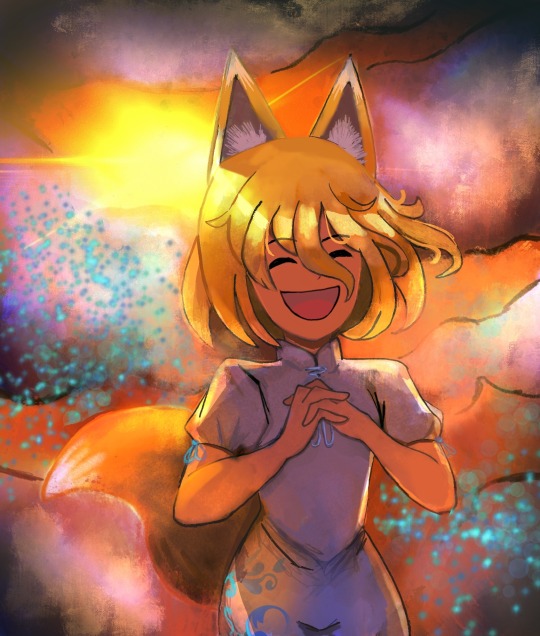

Secretly a very cut-throat fox.
I got an IPad recently and I’m trying out Procreate. I’ve been enjoying it so far.

Also since it’s th18 I couldn’t help but put this through a rainbow filter real quick.
130 notes
·
View notes
Text




touhous ...
#other characters#touhou#hecatia lapislazuli#kochiya sanae#clownpiece#kudamaki tsukasa#chimata tenkyuu#cirno#tewi
716 notes
·
View notes
Text
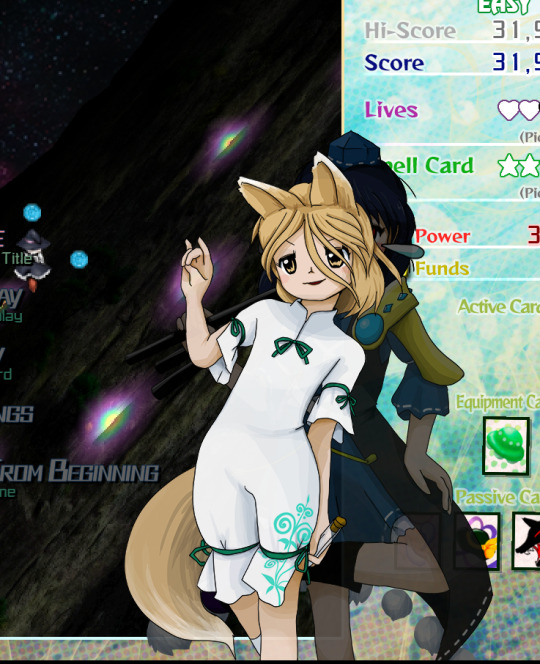
I took this screenshot when Unconnected Marketeers came out and asked, "Are foxes just Like This in Touhou?" I knew from the moment I saw this woman's scheming face that she was a little puntable ball of repressed emotions and expressed desires.
Sparkle on, it's Wednesday!
45 notes
·
View notes